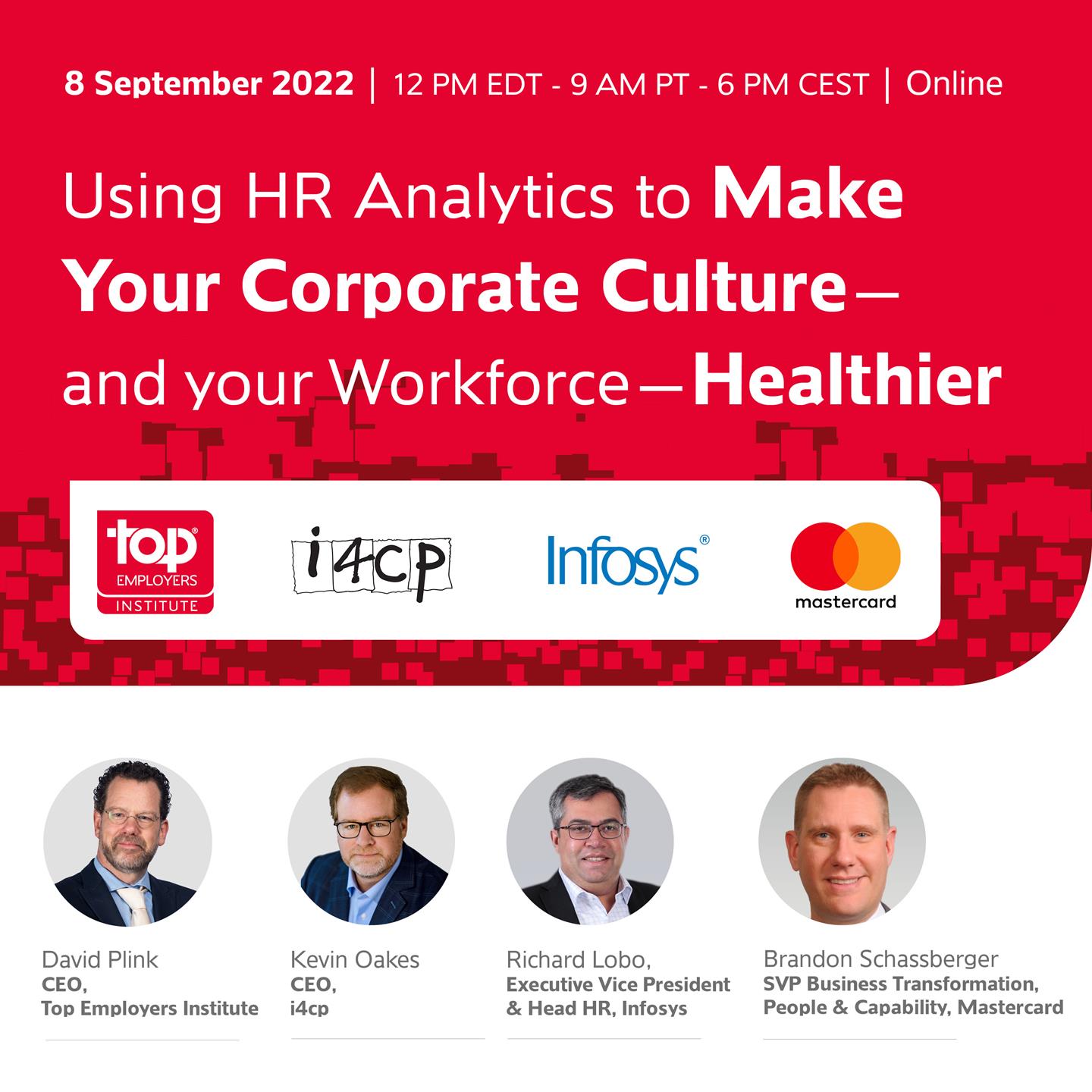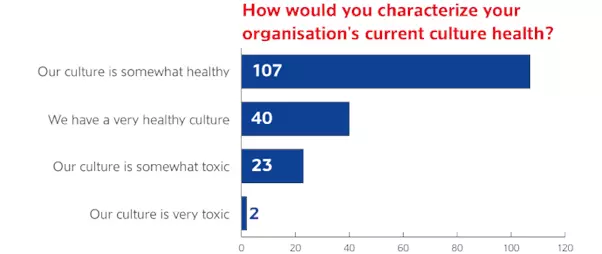Using HR Analytics to Make Your Corporate Culture—and your Workforce—Healthier

HR sits on a wealth of data today. Yet, when it comes to organisational culture, it's often a struggle to analyse meaningful data for CEOs, boards, and senior business leaders and what data to present.
In this webinar, Kevin Oakes, i4cp CEO and author of Culture Renovation®, and David Plink, CEO of Top Employers Institute, explored how HR can most effectively leverage existing human capital analytics to measure and monitor cultural health. Brandon Schassberger joined them, SVP Business Transformation, People & Capability at Mastercard and Richard Lobo, Executive Vice President & Head HR, Infosys, who shared how they use HR analytics at their respective companies.
Read ahead to get a snapshot of some of the session's highlights; fill in the form to get the recording of the webinar to watch whenever you have a moment.
The session started with a poll:

The number one answer was "Our culture somewhat healthy" (62%), followed by "our culture is very healthy" at 23%, making that a very good cumulative score of 85% of respondents saying somewhat or very healthy. i4CP, across various webinars and events, has asked this question, and the results are very similar.
i4Cp recently launched a survey to understand how companies deal with toxicity, even pockets of toxicity in their culture. And on the positive side, look at the elements of a healthy culture and what companies are doing to sustain that.
The risks of not using data
A notable trend is that many companies now have a lot of data – but many are not necessarily using it. There comes naturally with his associated risks. Kevin Oakes book “Culture Renovation: 18 Leadership Actions to Build an Unshakeable Company” emanated from a study done on corporate culture and the elements of a healthy culture overall.
And specifically, if companies want to change culture, how do they do it – a question many CEOs and senior executives posed. While the inherent importance of culture and the urgency to change it was understood, very little literature existed on ‘ how to do it. The book outlines 18 action steps that the organisation can take to renovate its culture.
Companies like Microsoft and Mastercard feature heavily in the book, as they have changed their culture over the last few years. They didn't completely transform those cultures. Instead, they carefully renovated those cultures to keep what made them good, to begin with, to keep the unique elements of that organisation.
Kevin noted, "One of the very first steps, though, before you start changing our culture, is to understand the cultural elements today. And I tell executive teams this all the time. If you lock yourself in a conference room and decide amongst yourselves what the Culture is, you're going to get it wrong.”
It's important to understand the employee sentiment, probably even more so today where we got remote, flexible or hybrid work. Understand where employees feel the problem is before you set out to change it. Engagement surveys are good for this, but they are at one point in time, and you don't get a lot of great information in just one annual engagement survey. More companies are using newer technologies to listen on devices using natural language processing and a little AI to understand what's happening in the workforce.
How Top Employer Infosys uses HR analytics to improve their corporate culture
Richard Lobo explained that Infosys has always used data for its clients. And unfortunately, not enough of the good work done by companies in the consumer space translates into the people space. The pandemic presented a great opportunity to accelerate the use of analytics. Infosys, an organisation with close to 300,00 employees, provides lots of data. Data that allows you to predict, like an automated guidance system to your car or aeroplane.
In the pre-pandemic stages, many of us used to have water cooler conversations and would run into each other in corridors, and most of these moments have now moved into a virtual / tech space. As a consequence, the data produced by systems got that much richer.
Infosys uses HR analytics in various ways.
- The first is through a program labelled Hale (Health assessment and lifestyle enrichment. Through this, both mental and physical well-being data is collected. Based on the various application uses and programs, they can link them to absenteeism metrics. Furthermore, it provides input into how teams are doing and how many hours they can work without having a negative impact.
- The second program they use is called Lex – Learning Experience & Careers Adaptive Learning and Digital Career paths, based on employee interest & skills. The online system can extract data to understand which skills are more in demand.
Conversely, Infosys also uses analytics to enhance employee experience and make work more 'human'.
- On average, an employee goes through 200 touch points (for example, when they want approval, mark attendance, access employee data, etc.) through one mobile app. Improvements are made along the way by understanding how employees use the app through the data collected.
- Finally, through a program called MCode – Manager effectiveness, Infosys can collect data to develop managers and provide people insights on the go through interactive dashboards and nudges.
Richard also noted how the Top Employers Programme assisted Infosys “ Because the whole certification experience, the interaction with the Top Employers team, has helped us advance the impact of people practices through shared learning. Because we've learned so much from other companies because no company can get everything right. Being able to drive change because the whole certification process, the process regulation helps you use your data better, and they might apply some of these things on an on a real-time experience.”
How Mastercard used a Cultural Health Index to measure cultural trends
Brandon explains that Mastercard started their culture journey maybe 3-4 years ago, as they looked at things such as ISO categories and looked at metrics and the industry standards – which didn't resonate with their cultures.
It's great to have these metrics externally, but it didn't provide any understanding or a way of measuring things that were important to them. At the same time as undergoing this exercise, there was a lot of unrest in the USA. There was a strong push from stakeholders and asset managers to be much more transparent.
Through collaboration with i4CP, Mastercard had a breakthrough moment in conversation with Kevin Martin (Chief Research Officer at i4cp). Mastercard noted the modelling for reporting and the use of indices. So, instead of using 30 different KPIs, they could arrange them into indices: Innovation, Inclusion, and Employer Brand. When these indices are aggregated and incorporate the retention statistics of Mastercard’s succession plans, they provide an objective, outcome-based view into the cultural trends that impact their organisation.
Breaking down one of those indices (Employer brand) - Mastercard recognised that they are one of the most valuable brands in the world – but this was not necessarily seen in their employer brand. Instead of only looking at their Glassdoor rating, for example, other perspectives were now being looked at - such as early career hires to customer voice of customer feedback to the engagement level of active people, Net promoter score, exits etc.
And thus, creating the indices helps you figure out what levers you have to pull and how they influence others.
The rest of the webinar focused on HR analytics and hot topics such as the great resignation, quiet quitting and the increasingly competitive talent market for organisations. To access the entire webinar, fill in the form on the right.





